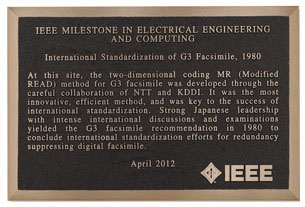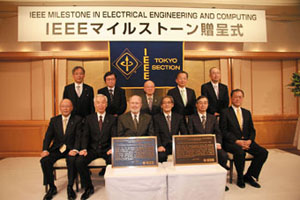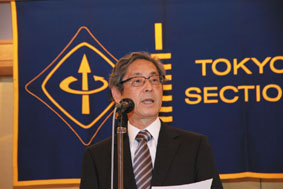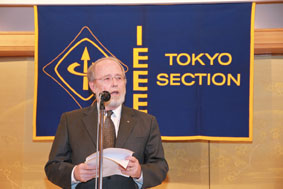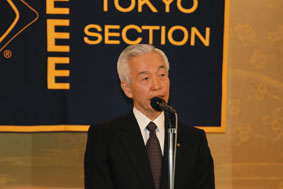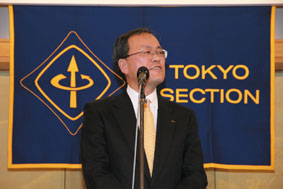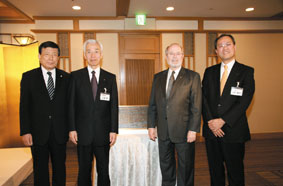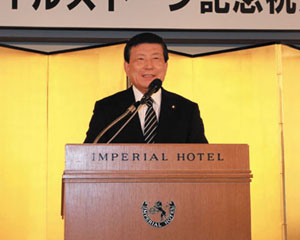 |
|||||||||||||
|
|
|||||||||||||
|
Information Vol. 10, No. 8, pp. 61–65, Aug. 2012. https://doi.org/10.53829/ntr201208in2 IEEE Milestone Dedication Ceremony for International Standardization of G3 FacsimileAbstractA ceremony dedicating the international standardization of G3 facsimile (fax) as an IEEE Milestone was held on April 5, 2012 at the Imperial Hotel in Tokyo, Japan. This article examines the international penetration of G3 fax and the innovation it brought to information transmission and reports on the ceremony in which commemorative plaques were presented and on the celebration that followed.
1. IntroductionAlthough the facsimile (fax) was invented*1 earlier than the telephone and was expected to offer many possibilities as a new means of communication, the complexity of the constituent technologies made it difficult to achieve compact and high-speed equipment. As a result, the worldwide development and penetration of fax systems remained at a standstill for many years. In Japan, however, where ideograms in the form of kanji (Chinese characters) are extensively used, it was considered that a fax system that could transmit a written document in its original form would be highly useful. Consequently, with the opening up of Japan's telephone network in the early 1970s, the Ministry of Posts and Telecommunications (now Ministry of Internal Affairs and Communications: MIC) joined forces with academic societies, telecommunications carriers, and communications equipment makers to promote the development and penetration of a fax system for office use. As part of this effort, NTT (then Nippon Telegraph and Telephone Public Corporation) and KDDI (then Kokusai Denshin Denwa Co. Ltd.) developed a coding method called READ*2 that combined the best features of each newly developed coding method. This method was submitted to the International Telegraph and Telephone Consultative Committee (CCITT, now ITU-T (International Telecommunication Union, Telecommunication Standardization Sector)) as a unified Japanese proposal. Then, on the basis of this proposal, the Modified READ (MR) method, which incorporates a few revisions to READ as requested by a number of countries to simplify the design of new facsimile equipment, became an international standard for G3 fax*3 in 1980. This elevation to an international standard gave a tremendous boost to the international penetration of fax, resulting in a giant step forward in the way that information is transmitted in both office- and home-use scenarios. On the basis of this worldwide penetration and innovation in information transmission, the international standardization of G3 fax was approved as an IEEE Milestone, which is known throughout the worldwide engineering community as a prestigious designation. An IEEE Milestone is an award presented by IEEE*4 to recognize the historical achievement of a technical innovation in the electrical, electronic, information, and communication fields. A technology recognized in this manner must have been developed at least 25 years ago and built up significant results from an international perspective. Both NTT and KDDI were presented with plaques from IEEE commemorating this approval of the international standardization of G3 fax as an IEEE Milestone (Fig. 1 and Photo 1).
2. IEEE Milestone presentation ceremony2.1 Greetings from hostsRepresenting the hosts of this presentation ceremony, Professor Tomonori Aoyama, IEEE Tokyo Section Chair, began the ceremony with an opening message (Photo 2). After providing some background about IEEE, which has more than 400,000 members worldwide and nine sections in Japan, he commented that 120 IEEE Milestones had been dedicated beginning with Benjamin Franklin's book entitled "Experiments and Observations on Electricity". He went on to say that the international standardization of G3 fax was the 17th IEEE Milestone dedicated to Japanese achievements, that Japan's dedications accounted for nearly 15% of all IEEE Milestones, and that Japan is the only country in Asia to have received IEEE Milestone approvals.
Professor Aoyama also said the following: "This approval of the international standardization of G3 fax as an IEEE Milestone was a result not only of the research and development efforts of NTT and KDDI but also of the support system provided by the Ministry of Posts and Telecommunications and academic societies at that time toward international standardization as well as of the efforts of various makers in advancing the development of actual hardware." 2.2 Presentation of plaques to NTT and KDDI by IEEE presidentNext, Dr. Gordon Day, President and CEO of IEEE, addressed the assembly (Photo 3). The appearance of the IEEE president at an IEEE Milestone dedication ceremony is rare, so Dr. Day's attendance here reminded all present of the importance IEEE placed on this dedication.
Dr. Day talked with great admiration about how collaboration between two leading telecommunications carriers (NTT and KDDI) led to the international standardization of G3 fax. Furthermore, from a personal standpoint, he looked back with fond memory at his surprise when first using a G3 fax machine, at which time he said, "I didn't know that such an amazing piece of equipment like this actually existed!" He went on to say, "A standard format that can bring about so much innovation in society can hardly be achieved by a single technology or single company." He praised the way that multiple technologies and resources were mobilized en masse to give birth to G3 fax. He also commented on the efforts that were made to maintain technological transparency and to achieve a degree of openness in the process of establishing this standard. He stressed that intense inter-corporate competition, instead of becoming an obstacle to mutual cooperation, actually promoted it because this standard was expected to lead to the formation of new markets. He concluded by saying, "I would like to express my deep respect to all who were involved in this great undertaking." After his talk, Dr. Day presented IEEE Milestone commemorative plaques to Satoshi Miura, President and CEO of NTT, and Takashi Tanaka, President of KDDI Corporation. There was much applause. 2.3 Greetings from NTT President and CEOSatoshi Miura, President and CEO of NTT, talked about the work that was undertaken to achieve high-speed, low-cost, and compact features to promote the penetration of fax communications after the opening up of the telephone network in 1971 and the efforts made toward standardization of G3 fax (Photo 4).
Mr. Miura also talked about the road to widespread fax use. He said, "The launching of the F-Net Service that provided flat-rate communications throughout Japan and the birth of fax machines with a market price under 100,000 yen accelerated the penetration of fax machines after the international standardization of G3 fax." In addition, he expressed his deep gratitude to the all-Japan effort of the Ministry of Posts and Telecommunications, academic societies, communications equipment makers, and other parties, since their efforts in forming an international market and ex-panding the spread of fax was directly related to this IEEE Milestone approval. Mr. Miura concluded his talk by saying, "The social mission of communications is becoming all the more important in the light of the Great East Japan Earthquake of 2011. Looking forward, we at NTT will continue our efforts in research and development toward the creation and penetration of new services with the aim of contributing to the advancement of global society." 2.4 Greetings from KDDI PresidentTakashi Tanaka, President of KDDI Corporation, began by expressing his gratitude to the Ministry of Posts and Telecommunications, academic societies, and various communications equipment makers. He then talked about the situation before G3 fax, when international business was dominated by the alphabet-based telex machine, and the inconvenience and time delays involved in sending pictures, photographs, and other types of graphical information separately by airmail (Photo 5).
He said, "The appearance of G3 fax completely eliminated the frustration of using telex machines—which cannot really express Japanese—and waiting for the arrival of airmail carrying drawings and other types of graphics. Not only did G3 fax contribute to the internationalization of Japanese business, it also promoted innovation through the creation of international markets for fax machines." In short, G3 fax helped to speed up and facilitate international business dealings and communications. Mr. Tanaka concluded his talk by saying, "At KDDI, we seek to contribute to the further advancement and internationalization of Japan with the conviction that innovation drives business." 3. IEEE Milestone celebration3.1 CelebrationFollowing the IEEE Milestone presentation ceremony, more than 130 individuals from NTT, KDDI, and IEEE as well as the Ministry of Posts and Telecommunications, academic societies, and various communications equipment makers gathered together to celebrate the dedication of the international standardization of G3 fax as an IEEE Milestone (Photo 6).
At the beginning of the party, Mr. Miura expressed his gratitude to all concerned, saying, "This dedication commends not just those of us present here today but also the many individuals making up the all-Japan effort from the Ministry of Posts and Telecommunications and makers, academic societies, and universities who worked hard for the international standardization of G3 fax and its penetration in society." He said, "NTT shares everyone's joy in this prestigious IEEE Milestone dedication. We hope to use this commendation as a seed of further research and development efforts with the aim of contributing to a resurgence of Japanese industry in the world." 3.2 Congratulatory messages from the Vice-Minister of MIC and other guestsCongratulatory messages were also received from various guests who honored the celebration with their presence. First to speak was Kimiaki Matsuzaki, Vice-Minister of MIC (Photo 7). He said, "As a representative of the Ministry of Internal Affairs and Communications, I would like to express my sincere gratitude to those of you who have said that the support system provided by the Ministry of Posts and Telecommunications at that time played a big role in getting Japan's two-dimensional MR coding method approved as the G3 fax international standard."
Mr. Matsuzaki stressed that information and communications technology (ICT) is Japan's major industry and that its further expansion holds the key to Japan's future growth. In this regard, he said, "I encourage all concerned to double your efforts as leaders in this industry to drive the expansion of Japan's technologies and products in world markets." Congratulatory messages were also received from Professor Hideki Imai, IEEE Japan Council Chair, Dr. Mitsutoshi Hatori, Chairman of The Telecommunication Technology Committee (TTC), and Yoshiyuki Sukemune, President of the Communications and Information network Association of Japan (CIAJ). A toast was then proposed by Mr. Tanaka of KDDI after which everyone began to socialize and engage in casual conversation. The hall was filled with anecdotes and stories from the past and friendships were renewed or fostered. Finally, after much conversation, Noritaka Uji, NTT Representative Director and Senior Executive Vice President, and Yoshiharu Shimatani, KDDI Senior Vice President and Member of the Board, each gave congratulatory messages to conclude the celebration on a high note. 4. Commemorative lectureThe celebration party was followed by an IEEE Milestone Commemorative Lecture consisting of three talks. The first talk entitled "IEEE Milestones" by Dr. Eiichi Ohno, IEEE Japan Council History Committee Chair, described the IEEE Milestones Program. The second talk entitled "Redundancy Reduction Coding Methods of G3FAX for International Standardization" by Dr. Toyomichi Yamada, presently Professor Emeritus of Musashi Institute of Technology and formerly a Senior Research Engineer at NTT Electrical Communication Laboratories, described the development of G3 fax coding techniques. Finally, the third talk entitled "Role and Effectiveness of International Standardization in G3FAX" by Dr. Yasuhiro Yamazaki, formerly a Professor at Tokai University and Senior Research Engineer at KDD R&D Laboratories, featured interesting stories about the difficulties endured during the G3 fax standardization process. This commemorative lecture is described in more detail in the first Information article this issue [1]. 5. ConclusionThe G3 fax system is still being used today in many businesses and homes throughout the world. By promoting global penetration, its international standardization has helped to change the way in which society transmits information and has made a great contribution to the expansion of various industries and the development of culture. Looking to the future, NTT wishes to use world-leading technologies to contribute to the further development of society, industry, and science and the creation of a safe, secure, and prosperous society. NOTE: The affiliations of the attendees are those at the time of the ceremony. Reference
|
|||||||||||||









